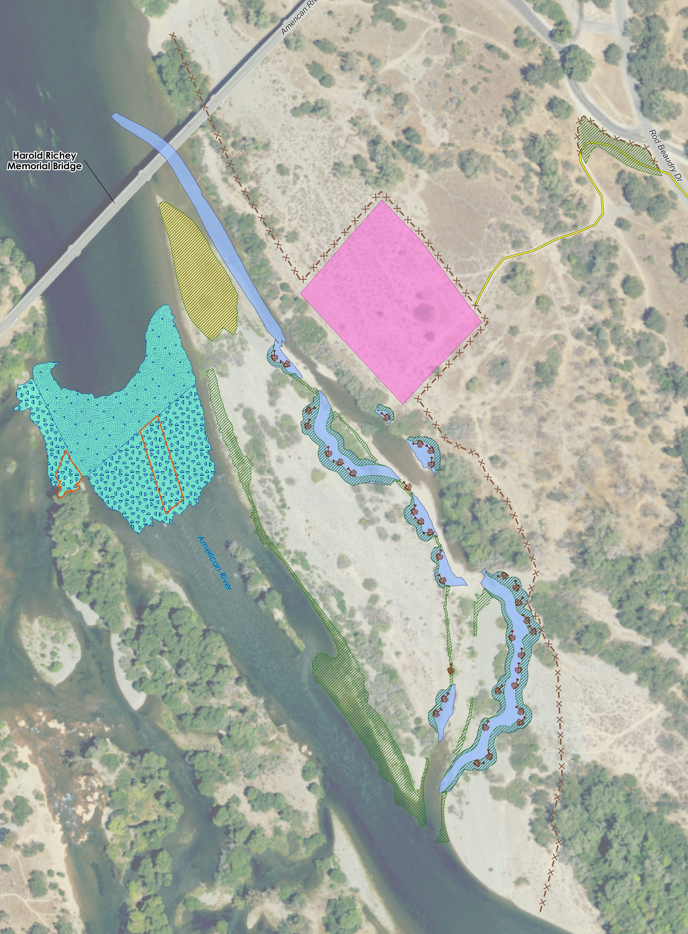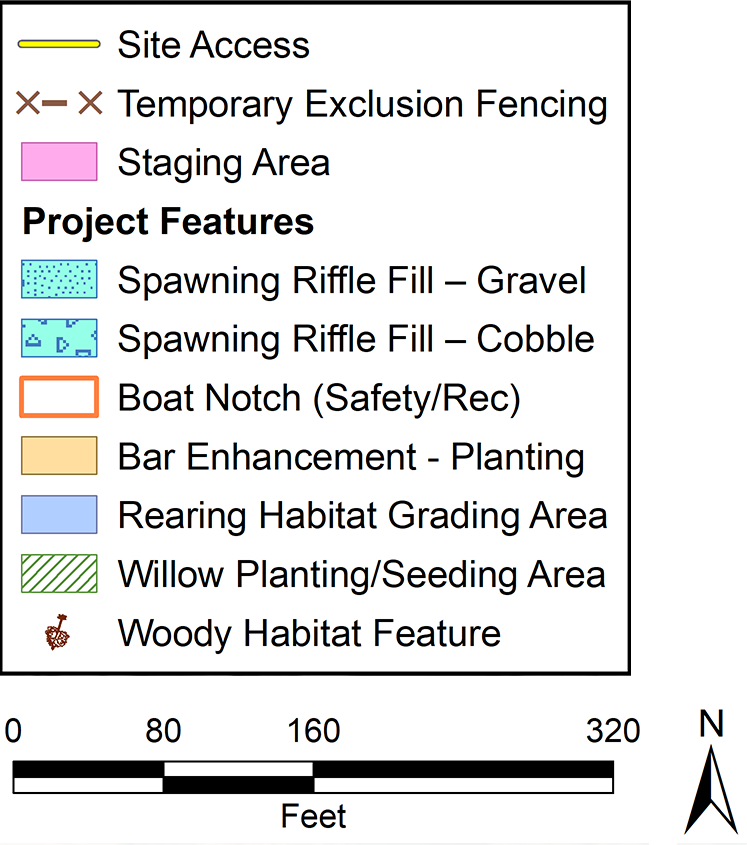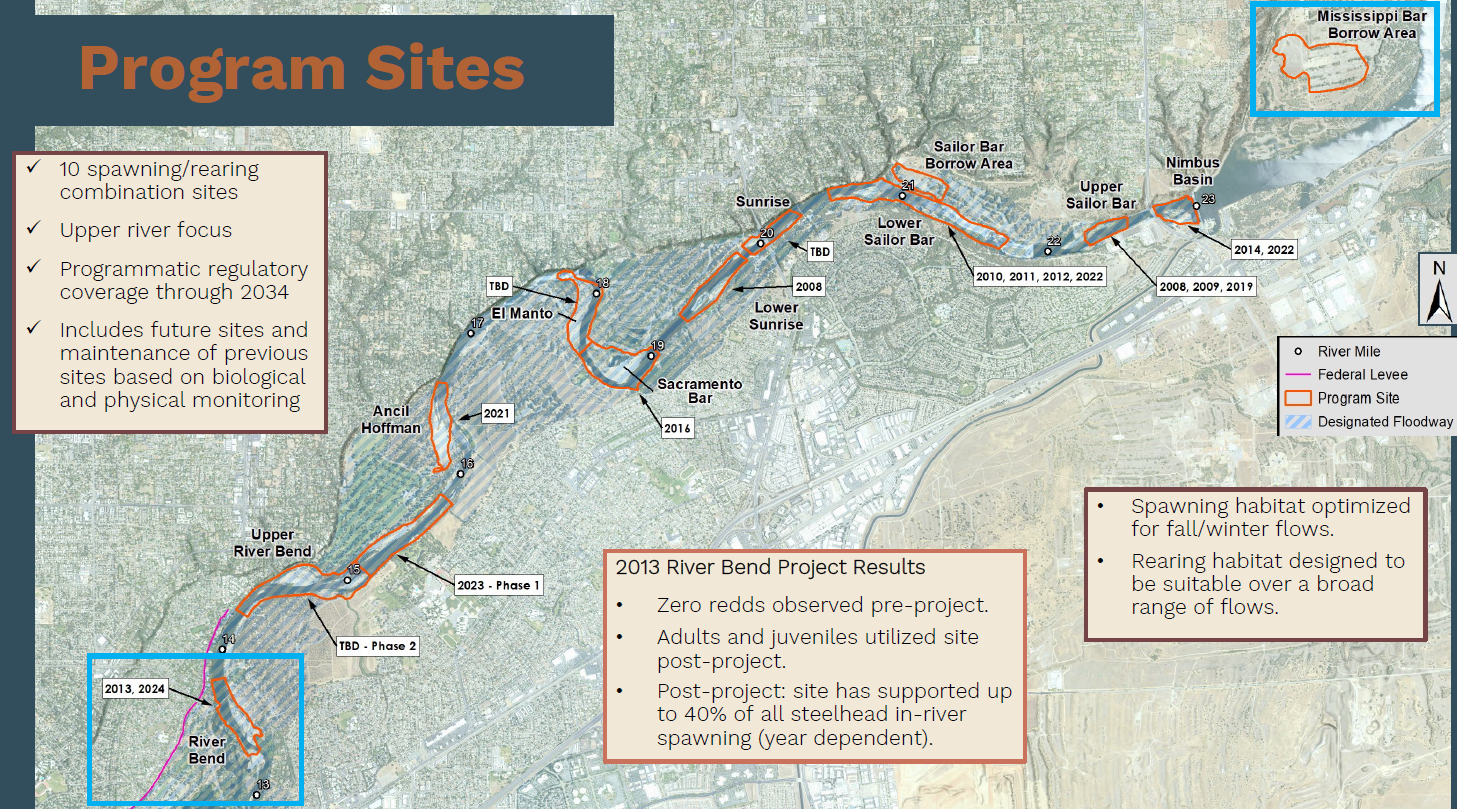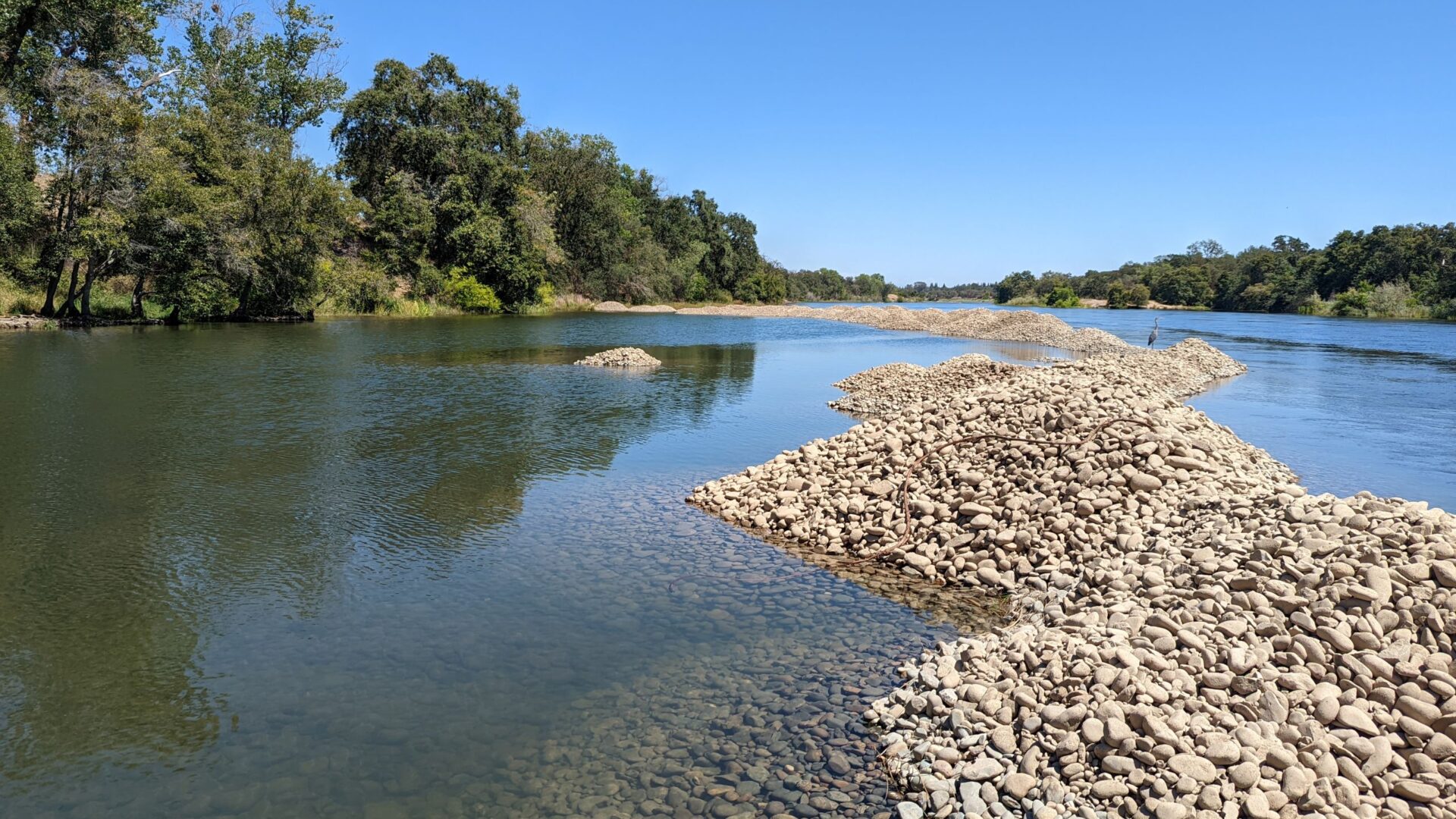Read the 2024 Habitat Project recap here.
Overview
Each year, the Water Forum works to create and enhance habitat for native fall-run Chinook salmon and steelhead trout. Both species migrate to the Lower American River as adults to spawn. Fall-run Chinook salmon generally spawn from October through December, while steelhead trout spawning occurs from January through March. In the egg-laying process, females create a “nest” (called a redd) in loose gravel in flowing water, deposit their eggs, and then cover them with more gravel. Once hatched, young fish move to the river’s slower-moving floodplain and side channel areas to find protection from predators and grow before swimming to the Pacific Ocean.
About the Project

The Water Forum’s 2024 Habitat Project enhanced crucial habitat for native fall-run Chinook salmon and steelhead trout at River Bend (in the river near River Band Park in Rancho Cordova and William B. Pond Recreation Area in Carmichael).
The project provided:
- Nearly 5 acres of spawning habitat for adult salmon and steelhead to create redds (underwater depressions or “nests”), constructed by placing 6,800 cubic yards of clean gravel into the flowing river.
- Over 3 acres of rearing habitat for young fish to hide from predators, find food and grow, created by deepening and reconnecting the existing 1,600-foot side channel with the main river and shaping 1 acre of seasonal floodplain.
- Hiding and resting places for young fish by placing about 35 large woody tree structures into the side channel.
- Over 2 acres of enhanced riparian landscape by planting or seeding the project area with willows and native flowers and grasses after construction.

Construction took place from August through October 2024, finishing before anadromous Chinook salmon returned in high numbers from the Pacific Ocean to the Lower American River.
- Thank you to the Bureau of Reclamation for partnering with the Water Forum and producing a fantastic video showcasing our collaborative efforts at River Bend. You can find the video here.
- Fox 40 reporter Dennis Shanahan shows project crews in action as they enhance spawning areas and work in the side channel to create safe spaces for young fish to grow. Check it out here.
- KCRA 3 featured the Water Forum’s 2024 Habitat Project at River Bend. Watch the segment here.
- Read the 2024 Habitat Project recap here.
- Read the 2024 Habitat Project fact sheet
- Read the 2024 Habitat Project mailer for local residents
- Access the Project Virtual Information Session (recorded July 24, 2024) here.
FREQUENTLY ASKED QUESTIONS
Why River Bend?
Habitat is limited: Each year, thousands of native salmon and steelhead adults use the Delta and Sacramento River like a highway to reach their native spawning areas in the Lower American River. Historically, they used over 100 miles of mainstem and upper watershed habitat before Folsom and Nimbus dams blocked their passage. Dams also trap vital sediment needed to replenish spawning areas that naturally erode over time in our dynamic river. The Water Forum identifies suitable areas like River Bend to replenish gravel to help stay ahead of these processes and support the wild fishery. In spring, newly hatched young fish use the same corridor to migrate out.
River Bend plays a crucial role as the first enhanced site salmon encounter as they return to the Lower American River.
Habitat enhancement works: In 2013, River Bend underwent enhancement efforts, yielding tangible results. Before the 2013 Habitat Project, no salmon were seen at the site. However, after the project, both Chinook Salmon and steelhead fish began using the River Bend spawning riffle and side channel. Even two years later, up to 159 Chinook nests and up to 21 steelhead nests were observed there, accounting for 25 percent of all steelhead nests seen that season.
The river is dynamic: Following the 2013 habitat project, juvenile salmon also began rearing in the River Bend site’s side channel. However, after a high-flow event in 2017 caused sediment buildup, there was an increase in juvenile stranding. With the side channel now blocked at lower flows, hundreds of young fish have been rescued from isolated pools following reductions in water flow. Moreover, although adult fish of both species still spawn at River Bend each year, overall usage has declined over time. This decrease highlights the importance of maintaining the site to ensure viable habitat areas in multiple sites along the river.

What visitors and neighbors can expect:
- Noise: Most of the noise is expected to come from trucks hauling gravel. Some noise will also come from constructing the spawning riffle and side channel. The project team contains this noise to the hours of 7 a.m. to 6 p.m. Monday-Saturday.
- Gravel hauling and tree delivery traffic: The project will deliver gravel sourced from Mississippi Bar in Fair Oaks and decommissioned orchard trees that will be reused for woody habitat. Hauling traffic is expected to occur Monday through Friday over 17 days with one to five trips per hour.
Trucks will travel to and from the project site via Rod Beaudry Road in Rancho Cordova. The construction team aims to minimize stops or parking on Road Beaudry Road and stagger truck movements in this area as much as possible.
- Bike trail access: The bike trail will remain open during construction. The hauling route will not cross the bike trail, and the construction team will employ traffic control personnel (flaggers) and signage to alert bicyclists and pedestrians to ongoing construction activities.
- River access for rafters: The project team is actively working to minimize disruptions to rafters, kayakers, and boaters navigating the area. The construction zone is downriver of the primary raft takeouts. In-river construction will be limited to weekdays, excluding Labor Day, with prominent signage posted at popular upriver entry points to notify boaters of ongoing work downstream. Throughout construction, the project team will remain alert to facilitate safe passage through the Arden Maze on the Carmichael side of the river or around the construction site.
- Shore access: To ensure public safety, access to the river bank from the shore will be blocked to the public within the construction areas. During off-work hours, construction areas and equipment will be secured with fencing and on-site security. The public will have access to the river along the shore in any area where it is safe.
- Site impacts: Gravel hauling will disturb the access area where trucks turn off Rod Beaudry Drive, toward the river. Following construction, project teams will enhance this area by removing invasive Yellow star-thistle and seeding with wildflowers and native grasses to enhance post-project aesthetics.
- Employee traffic: The project team includes about a dozen employees who will travel to and from the project site twice daily (at the beginning and end of the day) via Rod Beaudry Road.
- Equipment traffic: The project will use heavy equipment to move and place gravel into the river, as well as deepen a side channel. This equipment includes large bulldozers, excavators, front loaders and trucks. The equipment will move into and out of River Bend Park at the beginning and end of the project.
Note that the following are NOT expected to be impacted by construction:
- Access to the bike trail: The American River Bike Trail will remain open during construction with onsite traffic flaggers, fencing and signage to direct the public around construction areas and potential hazards.
- Access to the walking trail: The walking trail along the river will remain open with fencing and signage to direct the public around construction areas and potential hazards.
- Parking: Public parking is not expected to be impacted.
Thank You, Partners!
The 2024 Habitat Project is made possible by grant funding from the U.S. Bureau of Reclamation (Central Valley Project Improvement Act) and with the support of these partners:
- City of Sacramento
- Sacramento County
- Sacramento County Regional Parks
- The U.S. Bureau of Reclamation
- The U.S. Fish and Wildlife Service
- The California Department of Fish and Wildlife
- The Sacramento Area Flood Control Agency (SAFCA)

